1999 SUBARU LEGACY engine
[x] Cancel search: enginePage 870 of 1456
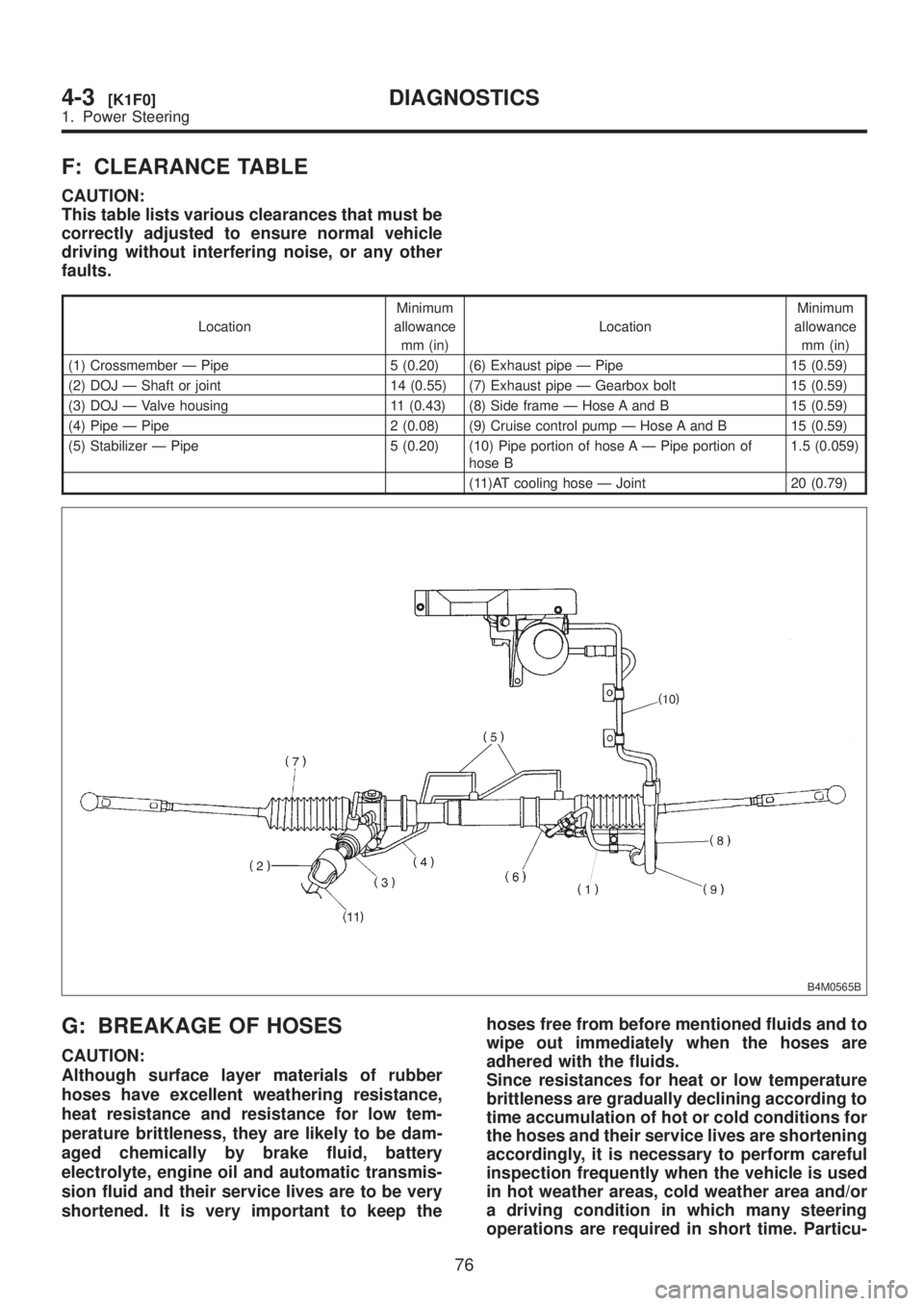
F: CLEARANCE TABLE
CAUTION:
This table lists various clearances that must be
correctly adjusted to ensure normal vehicle
driving without interfering noise, or any other
faults.
LocationMinimum
allowance
mm (in)LocationMinimum
allowance
mm (in)
(1) Crossmember Ð Pipe 5 (0.20) (6) Exhaust pipe Ð Pipe 15 (0.59)
(2) DOJ Ð Shaft or joint 14 (0.55) (7) Exhaust pipe Ð Gearbox bolt 15 (0.59)
(3) DOJ Ð Valve housing 11 (0.43) (8) Side frame Ð Hose A and B 15 (0.59)
(4) Pipe Ð Pipe 2 (0.08) (9) Cruise control pump Ð Hose A and B 15 (0.59)
(5) Stabilizer Ð Pipe 5 (0.20) (10) Pipe portion of hose A Ð Pipe portion of
hose B1.5 (0.059)
(11)AT cooling hose Ð Joint 20 (0.79)
B4M0565B
G: BREAKAGE OF HOSES
CAUTION:
Although surface layer materials of rubber
hoses have excellent weathering resistance,
heat resistance and resistance for low tem-
perature brittleness, they are likely to be dam-
aged chemically by brake fluid, battery
electrolyte, engine oil and automatic transmis-
sion fluid and their service lives are to be very
shortened. It is very important to keep thehoses free from before mentioned fluids and to
wipe out immediately when the hoses are
adhered with the fluids.
Since resistances for heat or low temperature
brittleness are gradually declining according to
time accumulation of hot or cold conditions for
the hoses and their service lives are shortening
accordingly, it is necessary to perform careful
inspection frequently when the vehicle is used
in hot weather areas, cold weather area and/or
a driving condition in which many steering
operations are required in short time. Particu-
76
4-3[K1F0]DIAGNOSTICS
1. Power Steering
Page 871 of 1456
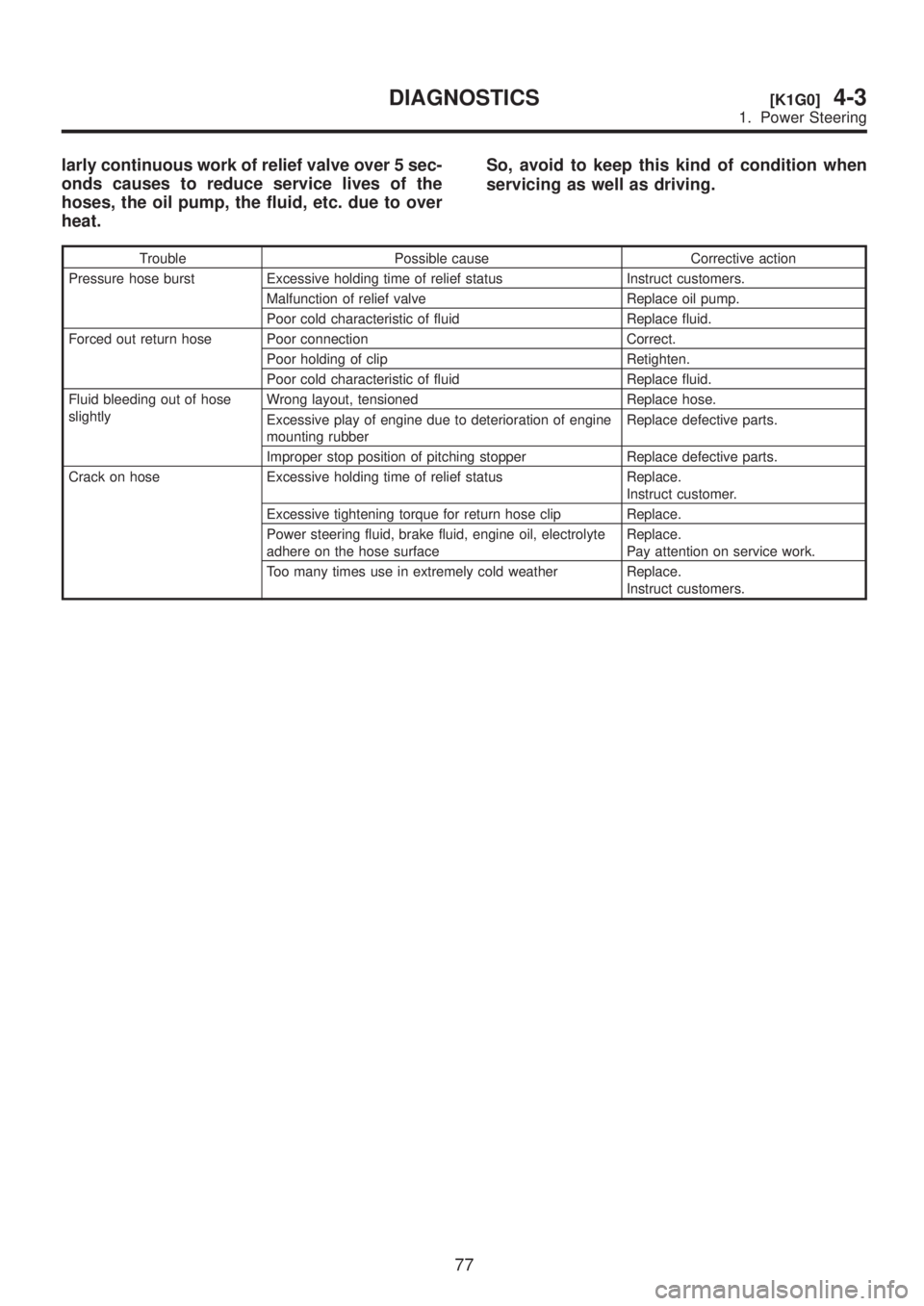
larly continuous work of relief valve over 5 sec-
onds causes to reduce service lives of the
hoses, the oil pump, the fluid, etc. due to over
heat.So, avoid to keep this kind of condition when
servicing as well as driving.
Trouble Possible cause Corrective action
Pressure hose burst Excessive holding time of relief status Instruct customers.
Malfunction of relief valve Replace oil pump.
Poor cold characteristic of fluid Replace fluid.
Forced out return hose Poor connection Correct.
Poor holding of clip Retighten.
Poor cold characteristic of fluid Replace fluid.
Fluid bleeding out of hose
slightlyWrong layout, tensioned Replace hose.
Excessive play of engine due to deterioration of engine
mounting rubberReplace defective parts.
Improper stop position of pitching stopper Replace defective parts.
Crack on hose Excessive holding time of relief status Replace.
Instruct customer.
Excessive tightening torque for return hose clip Replace.
Power steering fluid, brake fluid, engine oil, electrolyte
adhere on the hose surfaceReplace.
Pay attention on service work.
Too many times use in extremely cold weather Replace.
Instruct customers.
77
[K1G0]4-3DIAGNOSTICS
1. Power Steering
Page 873 of 1456
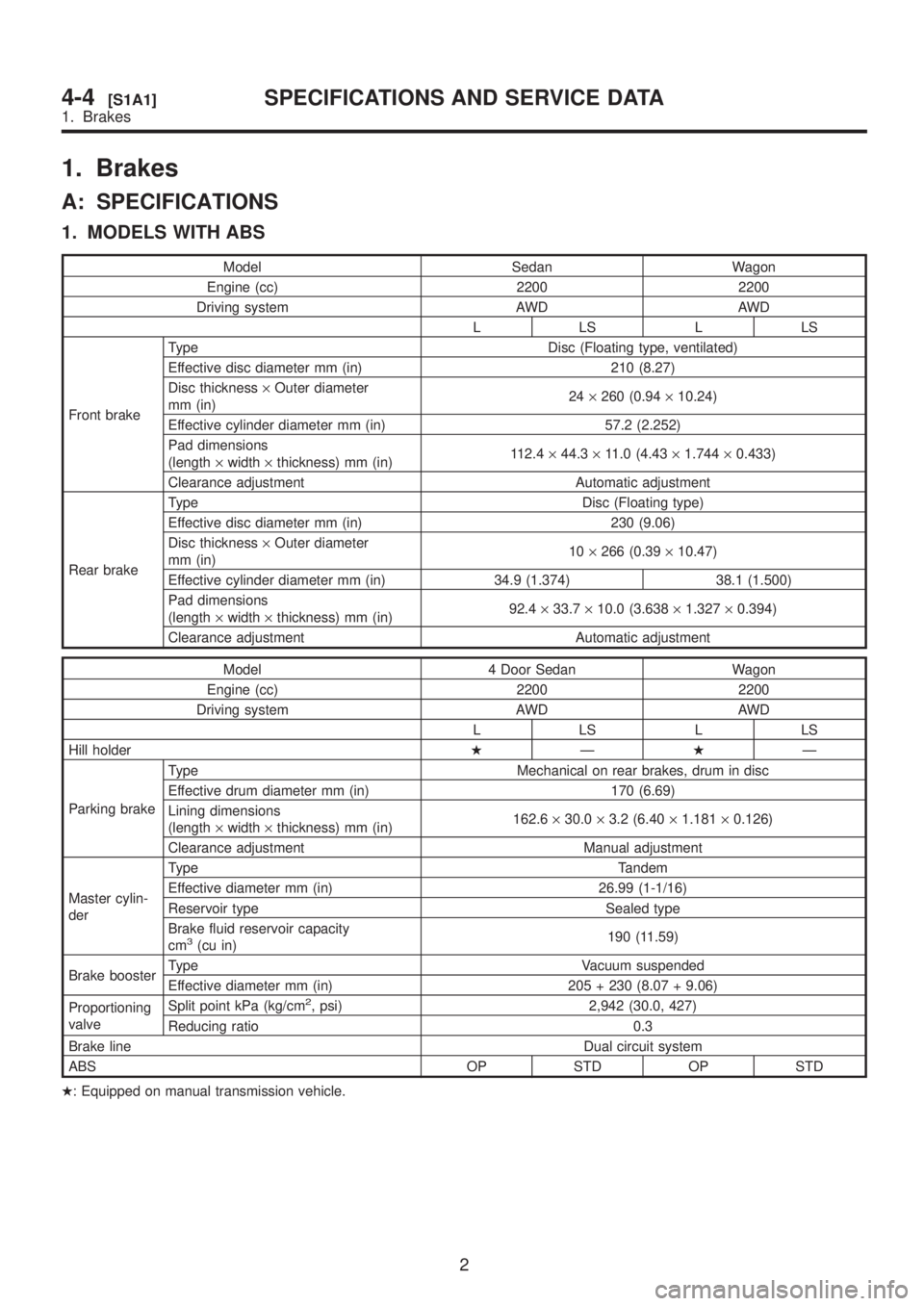
1. Brakes
A: SPECIFICATIONS
1. MODELS WITH ABS
Model Sedan Wagon
Engine (cc) 2200 2200
Driving system AWD AWD
LLSLLS
Front brakeType Disc (Floating type, ventilated)
Effective disc diameter mm (in) 210 (8.27)
Disc thickness´Outer diameter
mm (in)24´260 (0.94´10.24)
Effective cylinder diameter mm (in) 57.2 (2.252)
Pad dimensions
(length´width´thickness) mm (in)112.4´44.3´11.0 (4.43´1.744´0.433)
Clearance adjustment Automatic adjustment
Rear brakeType Disc (Floating type)
Effective disc diameter mm (in) 230 (9.06)
Disc thickness´Outer diameter
mm (in)10´266 (0.39´10.47)
Effective cylinder diameter mm (in) 34.9 (1.374) 38.1 (1.500)
Pad dimensions
(length´width´thickness) mm (in)92.4´33.7´10.0 (3.638´1.327´0.394)
Clearance adjustment Automatic adjustment
Model 4 Door Sedan Wagon
Engine (cc) 2200 2200
Driving system AWD AWD
LLSLLS
Hill holderHÐHÐ
Parking brakeType Mechanical on rear brakes, drum in disc
Effective drum diameter mm (in) 170 (6.69)
Lining dimensions
(length´width´thickness) mm (in)162.6´30.0´3.2 (6.40´1.181´0.126)
Clearance adjustment Manual adjustment
Master cylin-
derType Tandem
Effective diameter mm (in) 26.99 (1-1/16)
Reservoir type Sealed type
Brake fluid reservoir capacity
cm
3(cu in)190 (11.59)
Brake boosterType Vacuum suspended
Effective diameter mm (in) 205 + 230 (8.07 + 9.06)
Proportioning
valveSplit point kPa (kg/cm
2, psi) 2,942 (30.0, 427)
Reducing ratio 0.3
Brake lineDual circuit system
ABS OP STD OP STD
H: Equipped on manual transmission vehicle.
2
4-4[S1A1]SPECIFICATIONS AND SERVICE DATA
1. Brakes
Page 874 of 1456
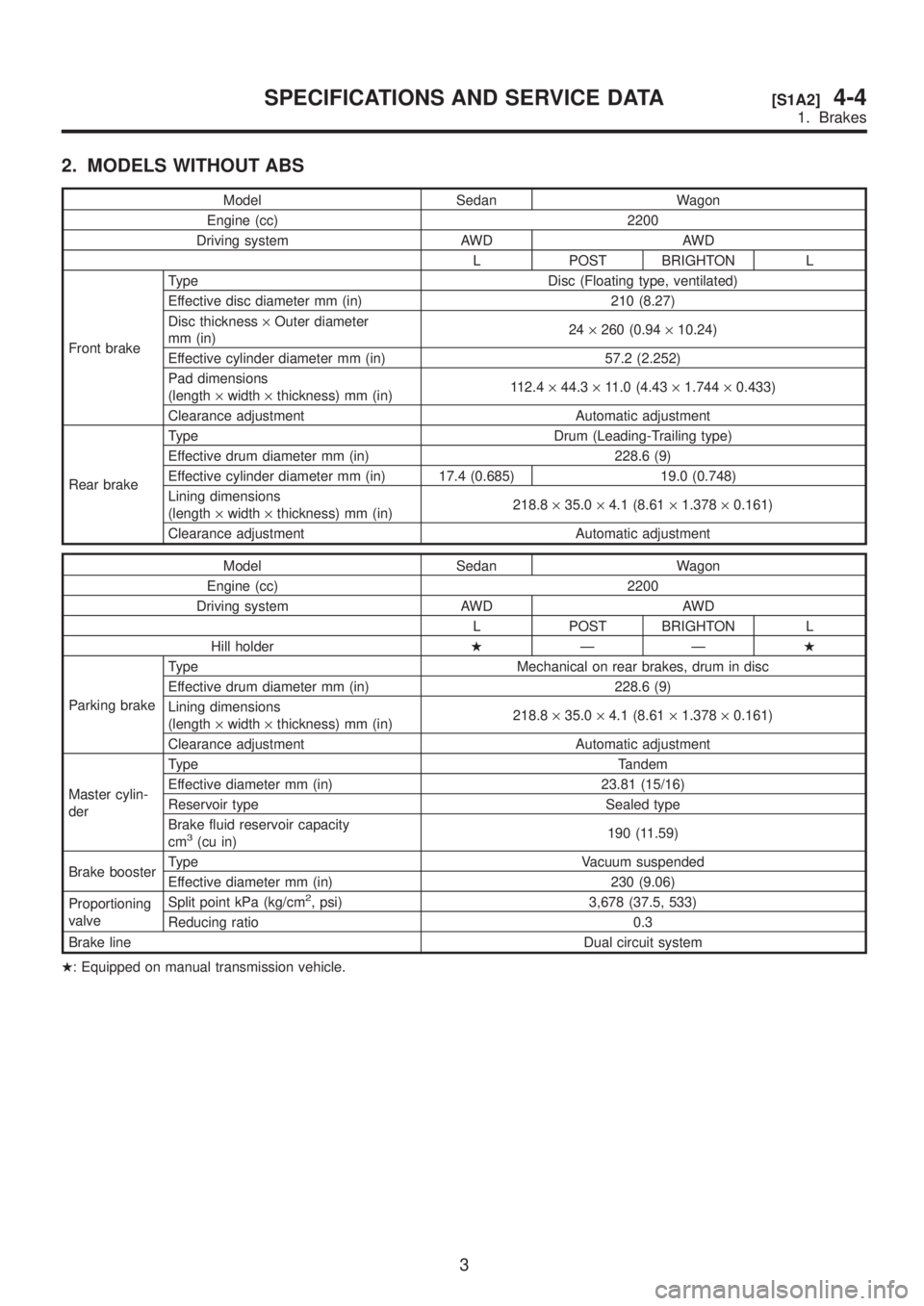
2. MODELS WITHOUT ABS
Model Sedan Wagon
Engine (cc) 2200
Driving system AWD AWD
L POST BRIGHTON L
Front brakeType Disc (Floating type, ventilated)
Effective disc diameter mm (in) 210 (8.27)
Disc thickness´Outer diameter
mm (in)24´260 (0.94´10.24)
Effective cylinder diameter mm (in) 57.2 (2.252)
Pad dimensions
(length´width´thickness) mm (in)112.4´44.3´11.0 (4.43´1.744´0.433)
Clearance adjustment Automatic adjustment
Rear brakeType Drum (Leading-Trailing type)
Effective drum diameter mm (in) 228.6 (9)
Effective cylinder diameter mm (in) 17.4 (0.685) 19.0 (0.748)
Lining dimensions
(length´width´thickness) mm (in)218.8´35.0´4.1 (8.61´1.378´0.161)
Clearance adjustment Automatic adjustment
Model Sedan Wagon
Engine (cc) 2200
Driving system AWD AWD
L POST BRIGHTON L
Hill holderHÐÐH
Parking brakeType Mechanical on rear brakes, drum in disc
Effective drum diameter mm (in) 228.6 (9)
Lining dimensions
(length´width´thickness) mm (in)218.8´35.0´4.1 (8.61´1.378´0.161)
Clearance adjustment Automatic adjustment
Master cylin-
derType Tandem
Effective diameter mm (in) 23.81 (15/16)
Reservoir type Sealed type
Brake fluid reservoir capacity
cm
3(cu in)190 (11.59)
Brake boosterType Vacuum suspended
Effective diameter mm (in) 230 (9.06)
Proportioning
valveSplit point kPa (kg/cm
2, psi) 3,678 (37.5, 533)
Reducing ratio 0.3
Brake lineDual circuit system
H: Equipped on manual transmission vehicle.
3
[S1A2]4-4SPECIFICATIONS AND SERVICE DATA
1. Brakes
Page 875 of 1456

3. 2500 cc MODEL
Model Sedan Wagon
Engine (cc) 2500
Driving system AWD
GT LSi GT LSi OUTBACK
Front brakeType Disc (Floating type, ventilated)
Effective disc diameter mm (in) 228 (8.98)
Disc thickness´Outer diameter
mm (in)24´277 (0.94´10.91)
Effective cylinder diameter mm (in) 42.8 (1.687)´2
Pad dimensions
(length´width´thickness) mm (in)112.3´50.0´11.0 (4.42´1.969´0.433)
Clearance adjustment Automatic adjustment
Rear brakeType Disc (Floating type)
Effective disc diameter mm (in) 230 (9.06)
Disc thickness´Outer diameter mm
(in)10´266 (0.39´10.47)
Effective cylinder diameter mm (in) 38.1 (1.500)
Pad dimensions
(length´width´thickness) mm (in)92.4´33.7´10.0 (3.638´1.327´0.394)
Clearance adjustment Automatic adjustment
Model Sedan Wagon
Engine (cc) 2500
Driving system AWD
GT LSi GT LSi OUTBACK
Hill holderÐÐÐÐÐ
Parking
brakeType Mechanical on rear brakes, drum in disc
Effective drum diameter mm (in) 170 (6.69)
Lining dimensions
(length´width´thickness) mm (in)162.6´30.0´3.2 (6.40´1.181´0.126)
Clearance adjustment Manual adjustment
Master cylin-
derType Tandem
Effective diameter mm (in) 26.99 (1-1/16)
Reservoir type Sealed type
Brake fluid reservoir capacity
cm
3(cu in)190 (11.59)
Brake
boosterType Vacuum suspended
Effective diameter mm (in) 205 + 230 (8.07 + 9.06)
Proportion-
ing valveSplit point kPa (kg/cm
2, psi) 3,678 (37.5, 533)
Reducing ratio 0.3
Brake lineDual circuit system
ABSSTD
4
4-4[S1A3]SPECIFICATIONS AND SERVICE DATA
1. Brakes
Page 876 of 1456
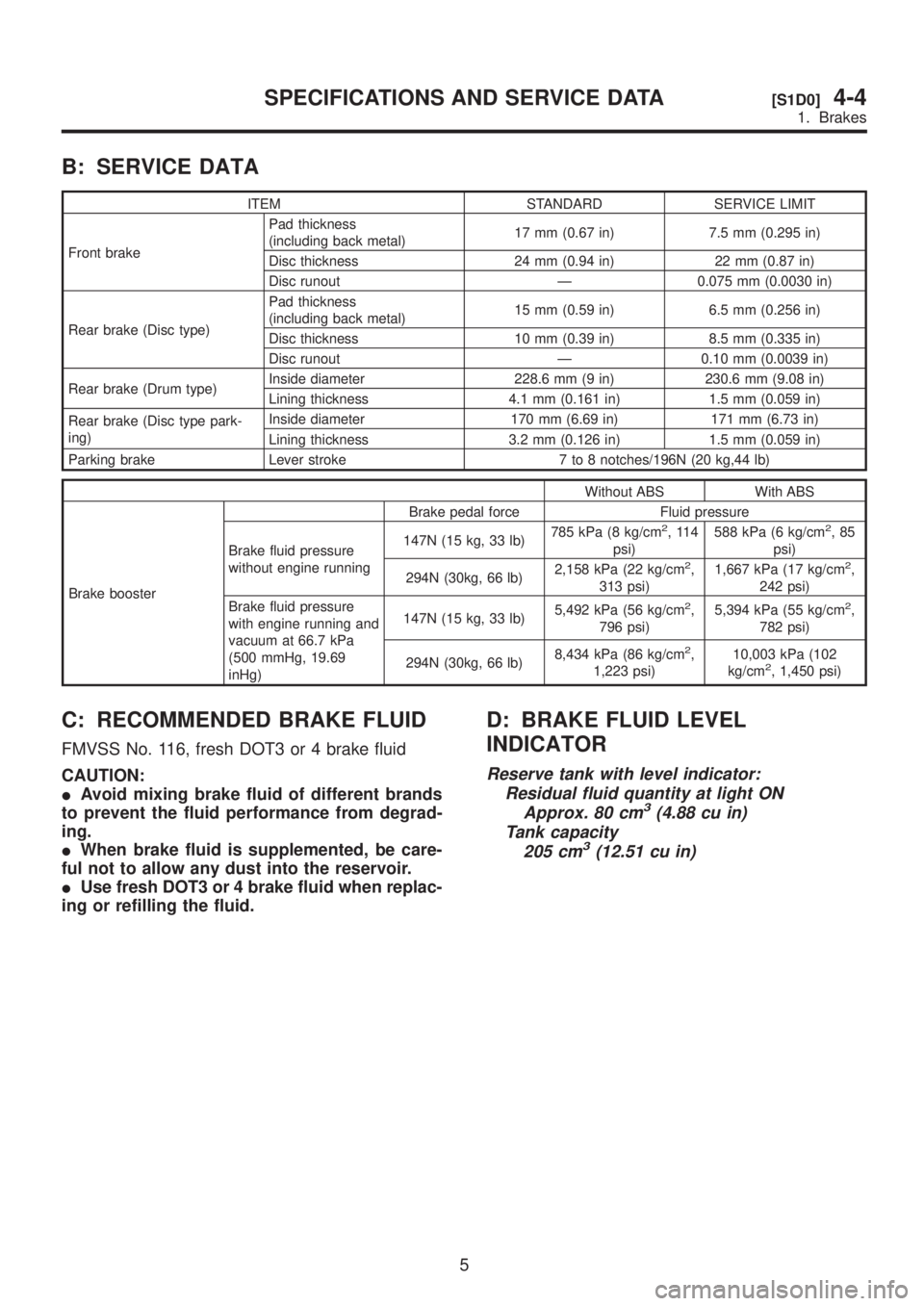
B: SERVICE DATA
ITEM STANDARD SERVICE LIMIT
Front brakePad thickness
(including back metal)17 mm (0.67 in) 7.5 mm (0.295 in)
Disc thickness 24 mm (0.94 in) 22 mm (0.87 in)
Disc runout Ð 0.075 mm (0.0030 in)
Rear brake (Disc type)Pad thickness
(including back metal)15 mm (0.59 in) 6.5 mm (0.256 in)
Disc thickness 10 mm (0.39 in) 8.5 mm (0.335 in)
Disc runout Ð 0.10 mm (0.0039 in)
Rear brake (Drum type)Inside diameter 228.6 mm (9 in) 230.6 mm (9.08 in)
Lining thickness 4.1 mm (0.161 in) 1.5 mm (0.059 in)
Rear brake (Disc type park-
ing)Inside diameter 170 mm (6.69 in) 171 mm (6.73 in)
Lining thickness 3.2 mm (0.126 in) 1.5 mm (0.059 in)
Parking brake Lever stroke 7 to 8 notches/196N (20 kg,44 lb)
Without ABS With ABS
Brake boosterBrake pedal force Fluid pressure
Brake fluid pressure
without engine running147N (15 kg, 33 lb)785 kPa (8 kg/cm
2,114
psi)588 kPa (6 kg/cm2,85
psi)
294N (30kg, 66 lb)2,158 kPa (22 kg/cm
2,
313 psi)1,667 kPa (17 kg/cm2,
242 psi)
Brake fluid pressure
with engine running and
vacuum at 66.7 kPa
(500 mmHg, 19.69
inHg)147N (15 kg, 33 lb)5,492 kPa (56 kg/cm
2,
796 psi)5,394 kPa (55 kg/cm2,
782 psi)
294N (30kg, 66 lb)8,434 kPa (86 kg/cm
2,
1,223 psi)10,003 kPa (102
kg/cm2, 1,450 psi)
C: RECOMMENDED BRAKE FLUID
FMVSS No. 116, fresh DOT3 or 4 brake fluid
CAUTION:
IAvoid mixing brake fluid of different brands
to prevent the fluid performance from degrad-
ing.
IWhen brake fluid is supplemented, be care-
ful not to allow any dust into the reservoir.
IUse fresh DOT3 or 4 brake fluid when replac-
ing or refilling the fluid.
D: BRAKE FLUID LEVEL
INDICATOR
Reserve tank with level indicator:
Residual fluid quantity at light ON
Approx. 80 cm
3(4.88 cu in)
Tank capacity
205 cm
3(12.51 cu in)
5
[S1D0]4-4SPECIFICATIONS AND SERVICE DATA
1. Brakes
Page 913 of 1456
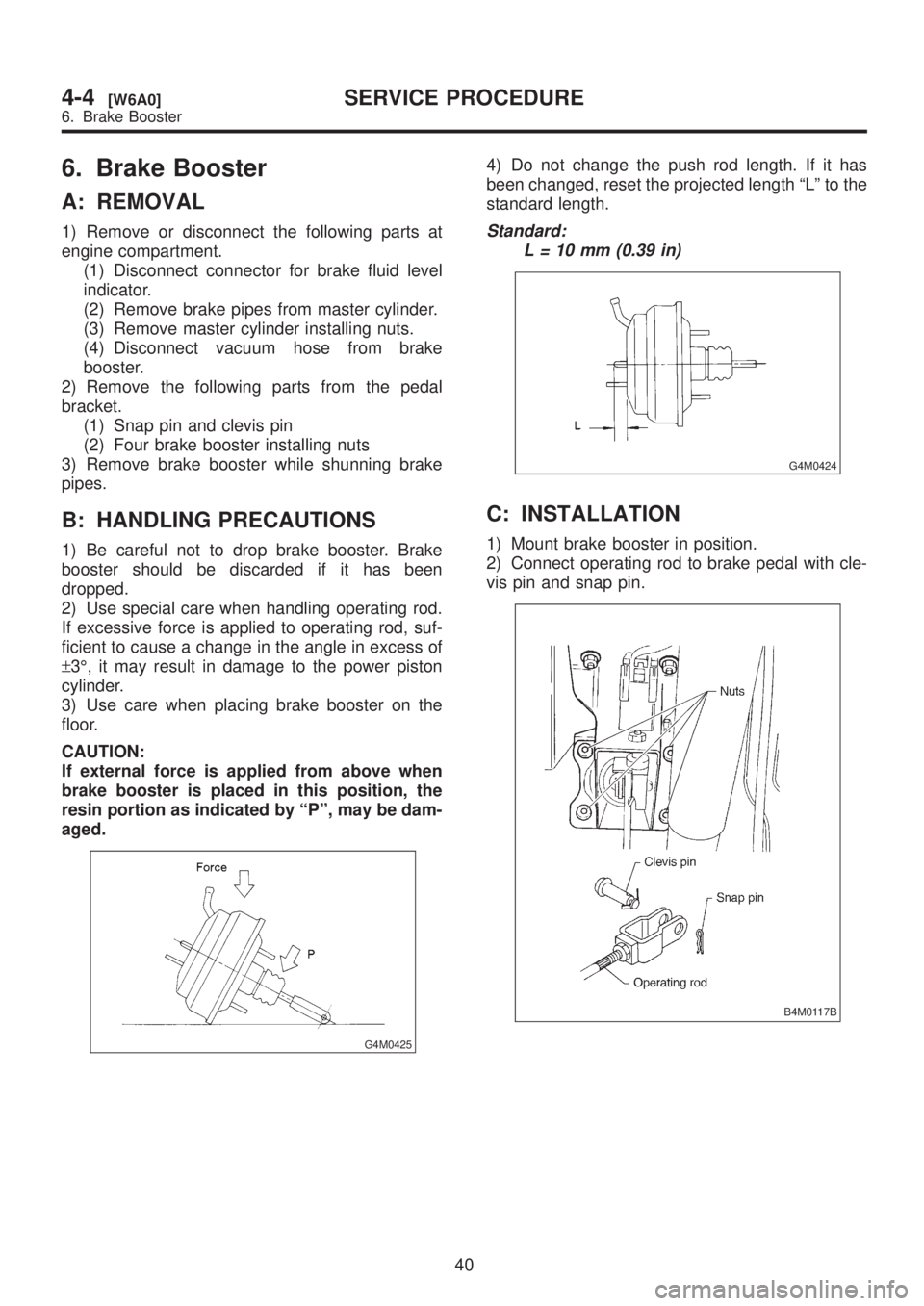
6. Brake Booster
A: REMOVAL
1) Remove or disconnect the following parts at
engine compartment.
(1) Disconnect connector for brake fluid level
indicator.
(2) Remove brake pipes from master cylinder.
(3) Remove master cylinder installing nuts.
(4) Disconnect vacuum hose from brake
booster.
2) Remove the following parts from the pedal
bracket.
(1) Snap pin and clevis pin
(2) Four brake booster installing nuts
3) Remove brake booster while shunning brake
pipes.
B: HANDLING PRECAUTIONS
1) Be careful not to drop brake booster. Brake
booster should be discarded if it has been
dropped.
2) Use special care when handling operating rod.
If excessive force is applied to operating rod, suf-
ficient to cause a change in the angle in excess of
±3É, it may result in damage to the power piston
cylinder.
3) Use care when placing brake booster on the
floor.
CAUTION:
If external force is applied from above when
brake booster is placed in this position, the
resin portion as indicated by ªPº, may be dam-
aged.
G4M0425
4) Do not change the push rod length. If it has
been changed, reset the projected length ªLº to the
standard length.
Standard:
L = 10 mm (0.39 in)
G4M0424
C: INSTALLATION
1) Mount brake booster in position.
2) Connect operating rod to brake pedal with cle-
vis pin and snap pin.
B4M0117B
40
4-4[W6A0]SERVICE PROCEDURE
6. Brake Booster
Page 914 of 1456
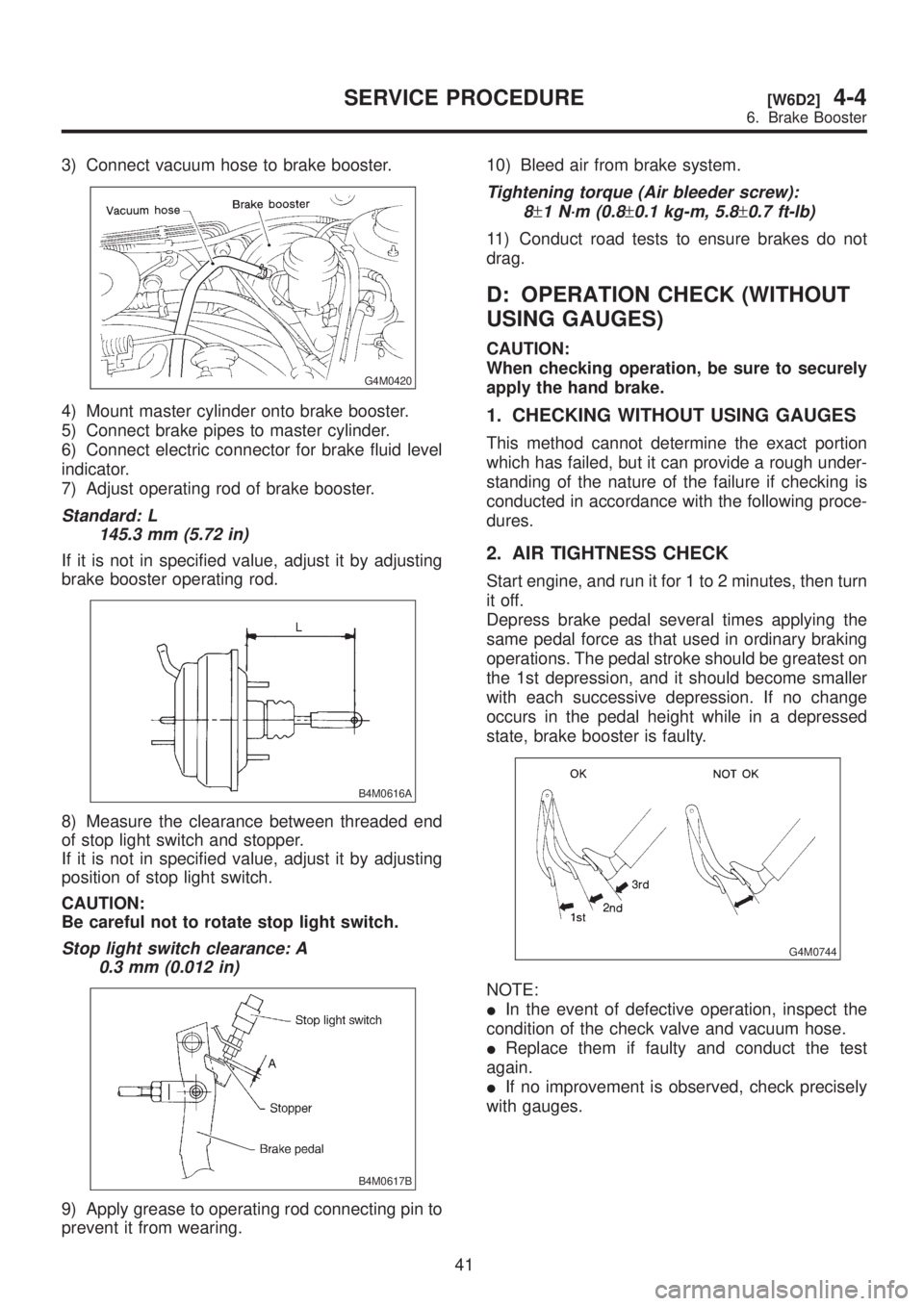
3) Connect vacuum hose to brake booster.
G4M0420
4) Mount master cylinder onto brake booster.
5) Connect brake pipes to master cylinder.
6) Connect electric connector for brake fluid level
indicator.
7) Adjust operating rod of brake booster.
Standard: L
145.3 mm (5.72 in)
If it is not in specified value, adjust it by adjusting
brake booster operating rod.
B4M0616A
8) Measure the clearance between threaded end
of stop light switch and stopper.
If it is not in specified value, adjust it by adjusting
position of stop light switch.
CAUTION:
Be careful not to rotate stop light switch.
Stop light switch clearance: A
0.3 mm (0.012 in)
B4M0617B
9) Apply grease to operating rod connecting pin to
prevent it from wearing.10) Bleed air from brake system.
Tightening torque (Air bleeder screw):
8
±1 N´m (0.8±0.1 kg-m, 5.8±0.7 ft-lb)
11) Conduct road tests to ensure brakes do not
drag.
D: OPERATION CHECK (WITHOUT
USING GAUGES)
CAUTION:
When checking operation, be sure to securely
apply the hand brake.
1. CHECKING WITHOUT USING GAUGES
This method cannot determine the exact portion
which has failed, but it can provide a rough under-
standing of the nature of the failure if checking is
conducted in accordance with the following proce-
dures.
2. AIR TIGHTNESS CHECK
Start engine, and run it for 1 to 2 minutes, then turn
it off.
Depress brake pedal several times applying the
same pedal force as that used in ordinary braking
operations. The pedal stroke should be greatest on
the 1st depression, and it should become smaller
with each successive depression. If no change
occurs in the pedal height while in a depressed
state, brake booster is faulty.
G4M0744
NOTE:
IIn the event of defective operation, inspect the
condition of the check valve and vacuum hose.
IReplace them if faulty and conduct the test
again.
IIf no improvement is observed, check precisely
with gauges.
41
[W6D2]4-4SERVICE PROCEDURE
6. Brake Booster